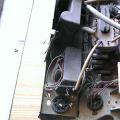Amd radeon settings does not open advanced settings. AMD Says Goodbye to Catalyst: New Radeon Software Crimson Software Platform Launched
In December 2014, AMD released a major update to the Catalyst Omega drivers, and almost a year later decided to permanently abandon the previous thirteen-year brand. The Radeon Software Crimson Edition released today includes the latest driver as well as the first edition of the new Radeon Software software platform. A more modern, faster and more convenient analogue of the Catalyst Control Center (CCC) was developed by the Radeon Technologies Group (RTG) unit formed last month and is designed not only to improve the quality of software, but also to increase energy savings and performance in games, as well as improve the quality of video playback, support for DirectX 12 and virtual reality technologies.
The Radeon Settings panel is opened by double-clicking on the icon in the taskbar or by selecting the appropriate option from the right-click menu on the desktop. The new interface, designed in a strict style, is written in QT and features a more convenient layout of elements and generally higher responsiveness: the software installs in three clicks (instead of seven in the case of CCC), and its launch is much faster than before.

Radeon Software offers the following key innovations:
- faster intuitive interface built from scratch;
- game manager;
- support for LiquidVR virtual reality technology;
- quality profiles and new features related to video playback;
- integration with social networks;
- simplified configuration of AMD Eyefinity technology for systems with multiple displays;
- system notification panel;
- shader caching;
- frame rate smoothing technology (Frame Pacing) version 3.0;
- the ability to configure various display settings (Custom Resolutions);
- Enhanced AMD Low Framerate Compensation (LFC) on AMD FreeSync-enabled displays;
- additional features of OpenCL 2.0.






One of the features of Radeon Software is increased energy savings. Compared to AMD Catalyst 15.7.1, the new version of the software makes it much more efficient to use the resources of the graphics accelerator and the entire system as a whole when watching HD videos on YouTube.

Frame rate control in applications on DX9, DX10 and DX11
Frame Rate Target Control (FRTC), first introduced in AMD Catalyst 15.7, now allows you to manually set the frame rate for DirectX 9 full-screen applications. The user can set any value between 30 and 200 fps. This feature helps to reduce the load on the GPU and, as a result, reduce noise and heat. Frame rate control is especially useful in the game menus and loading screens - in such cases, the image is often updated several hundred times per second.

AMD internal testing has shown that while limiting the frame rate to 90 fps in Rocket League running on DirectX 9, the Radeon R9 Fury X at 1080p saves up to 114 watts of graphics card power and up to 125 watts of system power as a whole.
As for games based on DirectX 10 and DirectX 11, in BioShock Infinite on the same video card in 4K resolution, with a frequency limit of up to 60 frames / s, you can achieve savings of 105 W and 107 W for the video accelerator and the entire system, respectively. The corresponding feature in Catalyst 15.7.1 saves no more than 50 watts. In Sniper Elite 3, when setting the limit to 55 fps, savings can reach 189 watts for the graphics adapter and 190 watts for the entire computer.
Improving performance in games

On the Radeon R9 Fury X at 1080p, you can get some performance gains in games compared to Catalyst 15.7.1: in Fable Legends it is 20%, in Call of Duty: Black Ops 3 - 8.22%. Optimized the work of some games on Linux (BioShock Infinite, Total War, Portal 2 and Dota 2 - performance increase varies from 112 to 155%).


Thanks to the shader caching function in many games, especially those with an open world, it is possible to achieve a reduction in load times, eliminate image “stuttering” due to CPU overload and short-term freezes. So, when this option is enabled, loading of the BioShock Infinite benchmark speeds up by 12%, and Endor maps in the Survival mode in Star Wars: Battlefront - by 34.5% (Radeon R9 380X, AMD FX 8370, 8 GB of RAM, Windows 10 ).


The update also introduced support for the Frame Pacing feature introduced in Catalyst 13.12 for DirectX 9 games (the graph below shows the results of its work using The Elder Scrolls V: Skyrim as an example) and improved the performance of FreeSync dynamic vertical synchronization technology during frequent drops frame rate. Low Framerate Compensation (LFC) on FreeSync-enabled displays smooths out frame rate spikes and eliminates image judder.



In addition, Radeon Software offers six video profiles that automatically activate certain features based on the current screen resolution, content being played, and the player being used. Users can adjust sharpness, brightness, color saturation, and enable AMD Fluid Motion Video and AMD Steady Video modes.


There are also two new features: Directional Scaling, which smooths out the 1080p image on a 4K display "stair effect", and adaptive dynamic contrast control to increase overall image contrast without affecting dark areas.


Finally, now users have the opportunity to manually set various display parameters: horizontal and vertical resolution, refresh rate, pixel rate, scan type, etc.

The package includes the AMD Unistall Clean Utility, which will remove previously installed Catalyst graphics and audio drivers, unused files, and registry entries.
Simultaneously with the release of Radeon Software Crimson Edition, the company shared some interesting statistics and some plans for the future. It turned out that since the release of AMD Catalyst Omega, drivers for video cards from its production have been downloaded over 60 million times. Next year, the company, as noted in the past, will release driver updates more frequently: in 2016 there will be up to six WHQL driver editions, while in 2015 there were three. Along with the main releases, AMD, as before, intends to release beta drivers.

You can download the package from the official website of the manufacturer. It is designed for 64-bit and 32-bit versions of Windows 10, Windows 8.1 and Windows 7, and Linux. The list of supported graphics cards for desktop systems starts with the AMD Radeon HD 7700 series and ends with the AMD Radeon R9 Fury (for laptops, from AMD Radeon HD 7700M to AMD Radeon R9 M300).
In 2018, many owners of Radeon video cards encountered an unexpected surprise from AMD programmers, in the form of an error message: Radeon Settings version and Driver version do not match. Please try again after updating to the latest version(s) , which is displayed when you try to open the control panel to change certain graphics card settings.
Google Translate helpfully suggests that the problem is a driver version mismatch with the software settings and suggests updating the video driver to the latest version.
I will say right away that no actions aimed at updating the video driver will fix the error. The author of this guide personally tried to repeatedly completely remove the video driver in safe mode using the Display Driver Uninstaller utility and then install earlier versions of the 18th line, up to 18.2.1 - the error persisted. I consider it inappropriate to install older versions of drivers, so I suggest spending a small amount of time and fixing this error once and for all.
0. Update the existing driver
Before all the “dancing with a tambourine”, I still recommend downloading the current version of the video driver for your video card model and operating system from the AMD website and updating the existing one.
In the depths of my soul, the hope does not leave me that the developers will come to their senses and correct this error. On the other hand, if it persists, then it's better to fix it in the latest version than to try to fix an outdated driver.
1. Launch the registry editor
To do this, simultaneously briefly press the key combination Win+R (in case you don't know, Win is the key that has the Windows logo on it).
In the opened window Run, enter the command regedit and press the button OK.

2. We fix the wrong value in the registry.
In the registry editor, sequentially open the branch (folder):
HKEY_LOCAL_MACHINE → SOFTWARE → AMD → CN
Inside this branch (folder) we find the parameter DriverVersion from which you want to remove the value. To do this, double-click on the parameter name, delete the value in the window that opens, and save the changed (empty) value.
After that, close the registry editor.

3. Apply fixes
You must restart the RadeonSettings.exe process for the fixes to take effect. The easiest way to do this is to restart your computer.
After the reboot, right-click on the screen and select the item from the drop-down menu AMD Radeon Settings, the graphics card control panel will open without error.
For some games, for example, for online shooters, it is not so much the quality of the picture that is important, but the high frame rate (number of frames per second). This is necessary in order to respond as quickly as possible to what is happening on the screen.
By default, all AMD Radeon driver settings are set in such a way that the highest quality picture is obtained. We will configure the software with an eye on performance, and hence speed.
AMD Graphics Settings
Optimal settings help increase FPS in games, which makes the picture smoother and more beautiful. You should not expect a big increase in performance, but you can “squeeze out” a few frames by disabling some parameters that have little effect on the visual perception of the image.
The video card is configured using special software that is part of the software that serves the card (driver) called AMD Catalyst Control Center.
- You can access the settings program by clicking PKM on the desktop.

- To simplify the work, include "Standard View" by clicking on the button "Parameters" in the upper right corner of the interface.

- Since we plan to configure settings for games, we are going to the appropriate section.

- Next, select a subsection with the name "Performance in games" and click on the link "Standard 3D Image Settings".

- At the bottom of the block we see a slider that is responsible for the ratio of quality and performance. Reducing this value will help you get a slight FPS boost. Uncheck the box, move the slider all the way to the left and click "Apply".

- Let's go back to the section. "Games" by clicking on the button in the breadcrumbs. Here we need a block "Image quality" and link "Smoothing".

Here we also uncheck all the boxes ( and "Morphological filtering") and move the slider "Level" to the left. Select the filter value box. Click again "Apply".

- Again we go to the section "Games" and this time click on the link "Smoothing Method".

In this block, we also remove the slider to the left.

- The next setting is "Anisotropic Filtering".

To configure this setting, uncheck the box next to "Use app settings" and move the slider towards the value "Pixel Sampling". Don't forget to apply parameters.

In some cases, these actions can increase FPS by 20%, which will give some advantage in the most dynamic games.
In this article, I will clearly show you how to set up a video card for maximum performance in games. This article is for those who have updated their drivers to the latest version with a modified interface.
To go to the graphics card driver control panel, you need to right-click on the desktop and select "Radeon settings".

In the window that appears, select the "Games" tab.

Then select "Global Options". When choosing global options, we set the settings for all installed games that you have.

In the global parameters, set the settings exactly the same as in the picture below.
1. Anti-aliasing mode: use application settings
2. Smoothing method: multiple sampling
3. Morphological filtering: off
4. Anisotropic filtering mode: use application settings
5. Texture Filtering Quality: Performance
6. Surface Format Optimization: Off
7. Wait for vertical update: off
8. Opengl Triple Buffering: On
9. Shader Cache: Off
10. Tessellation mode: use app settings
11. Energy efficiency: off
12. Frame rate control: off

Thanks to these settings, the FPS in games will be stable, and the game will be much more comfortable.
Any gamer at least once in his life dreamed of improving the graphic image on his screen without purchasing new expensive components, which are based on a video card. After all, even a hundred times passed a computer game begins to bring pleasure again, if its graphics have changed qualitatively.
The most advanced users and experienced IT specialists have long been faced with the task of squeezing the maximum out of the capabilities of video cards, but not all beginners have been able to solve it. Thus, after a detailed analysis of the current situation, AMD, which specializes in the production of Radeon video cards, decided to provide a set of tools () that allow you to programmatically optimize your video cards.
You can download drivers for a video card in the form of AMD Radeon Software Crimson Edition for free from the official AMD website or our website using the links below.

AMD Radeon Software Crimson Edition is a practical and very easy-to-use program that can significantly speed up any AMD video card, increasing its performance in games, and thereby allowing you to save a lot on the purchase of new equipment.
Note that this is not the first attempt by the company to create such an accelerator for their video cards, but this time the developers managed to fully realize their idea, and at the same time make the utility interface more understandable even for novice users.
Benefits of this software
By downloading and installing AMD Radeon Software Crimson Edition on your Windows PC, you can noticeably speed up the work of your graphics hardware, which will more economically and intelligently allocate available resources. With the new utility, the user gets access to control the broadcast of video materials, adjust graphics settings, interact with the display and other interesting features. The high ratings of Radeon Software Crimson Edition from recognized professionals are by no means accidental.
The fact is that this program is already part of a promising project called LiquidVR. AMD developers are seriously busy creating the most productive and versatile platform that simplifies the formation of a full-fledged virtual reality. Using new LiquidVR technologies, third-party professionals will be able to maximize the user experience with virtual reality headsets. This incredibly important breakthrough for the industry will help achieve the deepest and most convenient immersion in virtual worlds.
The re-named Radeon Settings interface is designed to be incredibly simple, so that even a novice PC user has the opportunity to make the necessary improvements to the performance of AMD graphics components. The program always functions stably without strange mysterious failures, and the details of its overall design are pleasing to the eye, but do not distract from the main task, allowing you to quickly find all the necessary tabs and icons and speed up the video card.

In addition, the developers managed to significantly improve the operation of the Flip Queue Size function, which is responsible for the rapid signal transmission from the keyboard and mouse, which will please absolutely every gamer. After all, it's so insulting when, during a hot battle, your hero does everything very late, unlike his enemies. And with the useful shader caching feature, the toy will load and run much faster than usual.
additional information
If you're the proud owner of an AMD A-series APU, Radeon Software Crimson Edition can greatly increase the overall number of settings that bring picture quality to a higher level.
The new version of the utility at the hardware level is able to support the DisplayPort-HDMI 2.0 key.
conclusions: With such advanced software, you don't have to update components too often, because it will become much easier to achieve the most pleasant result of the graphics hardware. To do this, simply download AMD Radeon Software Crimson Edition from the link below.
 Do-it-yourself stabilizer - diagrams and recommendations on how to make a rectifier
Do-it-yourself stabilizer - diagrams and recommendations on how to make a rectifier Voltage stabilizer circuit
Voltage stabilizer circuit We extract radio components from various electronic trash How to make a radio receiver on a variable capacitor
We extract radio components from various electronic trash How to make a radio receiver on a variable capacitor